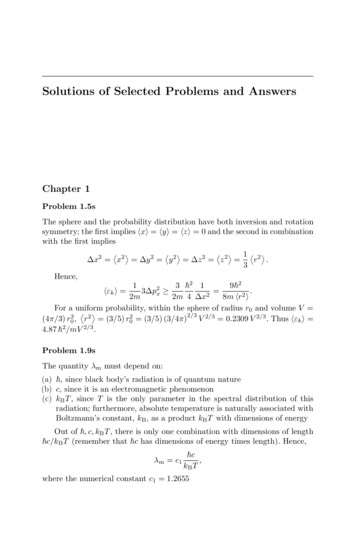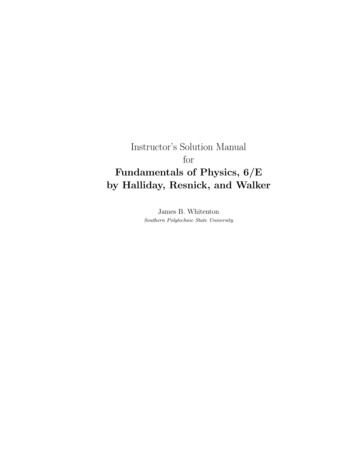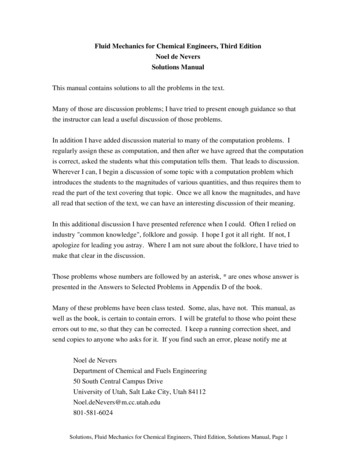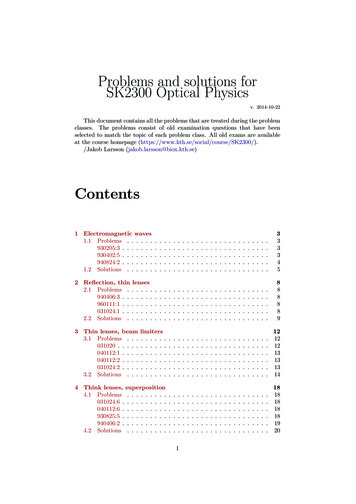
Transcription
Solutions of Selected Problems and AnswersChapter 1Problem 1.5sThe sphere and the probability distribution have both inversion and rotationsymmetry; the first implies x y z 0 and the second in combinationwith the first implies 1 2 Δx2 x2 Δy 2 y 2 Δz 2 z 2 r .3Hence,13 2 19 23Δp2x . εk 2m2m 4 Δx28m r2 For a uniform probability, within the sphere of radius r0 and volume V (4π/3) r03 , r2 (3/5) r02 (3/5) (3/4π)2/3 V 2/3 0.2309 V 2/3 . Thus εk 4.87 2/mV 2/3 .Problem 1.9sThe quantity λm must depend on:(a) , since black body’s radiation is of quantum nature(b) c, since it is an electromagnetic phenomenon(c) kB T , since T is the only parameter in the spectral distribution of thisradiation; furthermore, absolute temperature is naturally associated withBoltzmann’s constant, kB , as a product kB T with dimensions of energyOut of , c, kB T , there is only one combination with dimensions of length c/kB T (remember that c has dimensions of energy times length). Hence,λm c1 c,kB Twhere the numerical constant c1 1.2655
780Solutions of Selected Problems and AnswersProblem 1.10sThe scattering cross-section has dimensions of length square. The photonscattering by electron must depend on:(a) The electron charge, e, since, if this charge was zero, there would be nointeraction and no scattering.(b) The velocity of light, since we are dealing with an electromagnetic phenomenon.(c) The mass of the electron, me , since if the mass was infinite, the electronwould not oscillate under the action of the photon electromagnetic fieldand would not emit radiation.(d) The energy of the photon, ω.The quantity e2 /4πε0 me c2 has dimensions of length (since e2 /4πε0 r hasdimensions of energy). Hence, the cross-section, σ, is of the form σ e24πε0 me c2 2 ω,fm e c2where the function f of the dimensionless quantity ω/mec2 cannot be determined from dimensional analysis; it turns out that f (x) is a monotonicallydecreasing function of x with f (0) 8π/3, and f ( ) 0. (The formula forσ is known as the Klein–Nishina formula).Problem 1.11sThe natural linewidth, ΔE, has dimensions of energy. It must depend on:(a) The dipole moment p e · r (as suggested by the question).(b) The velocity of light, c since the decay is due to the emission of a photon.(c) The frequency of the emitted photon, since only an oscillating dipole emitsradiation.Hence, by finding the only combination of p, c, ω with dimensions ofenergy, we obtainΔE c14πε0 c3 e2 r 2 ω 3 and the lifetime tl ,34πε0 cΔEc1 e 2 r 2 ω 3where the “constant” c1 depends on the details of the initial and the finalatomic level, since actually r2 is the square of the matrix element of an appropriate projection of r between the initial and the final states. We expect that,for the transition 2p to 1s in hydrogen, r2 to be of the order of a2B . Choosing,arbitrarily, c1 1 and r2 a2B , while ω 13.6 1 14 eV 10.2 eV we findfor this transitiontl 1.17 10 9 s,while a detailed advanced calculation gives tl 1.59 10 9 s.
Solutions of Selected Problems and Answers781Problem 1.12sThe effective absolute temperature, T , would appear as the product kB T ofdimensions of energy. It must depend on:(a) The product GM , where G is the gravitational constant. The reason isthat the strong gravitational field responsible for this radiation dependson the product GM .(b) Planck’s constant , since the phenomenon is of quantum origin.(c) The velocity of light, c, since we are dealing with electromagnetic radiation.The reader may convince himself that out of GM , and c there is onlyone combination to give dimensions of energy, namely, c3 /GM . HencekB T c1 c3 /GM,where the numerical constant c1 turns out to be equal to 1/8π.Problem 1.13sIt is more convenient for dimensional analysis to employ the G-CGS system(to get rid of ε0 and μ0 ). The skin depth will depend on:(a)(b)(c)The frequency ω (see the statement of the problem).The velocity of light c (EM phenomenon).Theσ (we are dealing with a good conductor). But [σ] 2 conductivitye / aB [t] 1 . Hence,δ c1ωωf; it turns out that fωσσσ1 .2πChapter 2Problem 2.3sAccording to the book by Karplus and Porter [C65], the minimum of the curveappears at d 0.74 A 1.4 a.u. and it is equal to 4.75 eV. Assuming thatat d 5 a.u., the energy is still given by the van der Waals, we haveεd̄ 5 6.48/d 6 a.u. 6.48/56 a.u. 11.3 meV.At d 0.5 a.u., the total energy (excluding the proton–proton repulsion)is expected to be slightly higher than the total electronic energy of the Heatom. The latter energy is equal to minus the sum of the first and the secondionization potential of He, i.e., 24.587 54.418 eV 79 eV. To this energywe must add 2 13.6 eV to be consistent with our choice of the zero of energy.
782Solutions of Selected Problems and Answers2Thus the total energy at d 0.5 a.u. is higher than 79 27.2 4πεe 0 d 51.8 27.20.5 eV 2.6 eV.In Fig. 2.5, we plot the experimental curve and the two points weestimated above.Fig. 2.5. Interaction energy of two hydrogen atoms vs their separationProblem 2.5s 11 ψ(r) 2 Ae 2r/a ,4πr2 dr ψ 2rr0 2 2r/adrre1/ (2/a)10 3 a,2 2r/adrr e2/ (2/a) 0 4 2r/a 2 drr e4!/ (2/a)5ar 0 3 4 3 22 2r/a2!/ (2/a)0 drr e2 3a2 ,
Solutions of Selected Problems and Answersp22m 783 d4π 2dψdψr24πr2 dr ψr2drdr2mdrdr 2 d r/a dr dr edr 2 0 e r/a dr 2 2 a/4 ,32m2m 2a /82ma2drr2 e 2r/a0 22m ψ1 dr2 dr ε 4πε0 2 0 a 2 aB , ae m1 2 1 2p Δp2i ,33 a21 2 3 21r a a2 , Δp2i Δx2i 2 ,Δx2i 333 2e2, 2ma24πε0 a Δr r2 3aB , ε vs. Δp2i Δx2i 24 .Problem 2.6sSolving the systemr r 1 r 2,R (m1 r 1 m2 r 2 ) / (m1 m2 ) ,with respect to r 1 , r 2 , we findm2m1r, r2 R r.MMHence, taking into account that p 1 m1 ṙ1 , p 2 m2 ṙ2 , we haver1 R 2μ2 ṙ2m1 Ṙp 21 μṘṙ,2m122m1Summing the two equations we find2μ2 ṙ2p 22m2 Ṙ μṘṙ.2m222m2p2p211P2p 212 , QED. 2 M Ṙ μṙ 2 2m12m2222M2μProblem 2.8sβFrom virial theorem E 1 β2 V̄ , where V (x) x . According to thecorrespondence principle (valid for large n), to go from the level n to leveln 1, V̄ must go from V̄ (x) to V̄ (x δx), where δx λ; but λ 2 EK E.Thus V̄ V̄ 1 .δE E(n 1) E(n) λ x x EButδE (dE/dn) αE/n E/E 1/a E 1 (1/a) , V̄βλ β x / x λ V̄ 1 (1/β) E 1/2 . xsince E na ,
784Solutions of Selected Problems and AnswersSubstituting in δE ( V̄ / x)λ the last two relations and taking into accountthat E V̄ , we have11111E 1 a V 1 β E 2 E 1 β 2 ,or111 a a2 β 11 2 β 1.(1)In spite of the hand-waving character of “deriving” (1), the latter is valid(for every n) for β 2 (harmonic potential) and for β 1 (Coulombpotential), since the exact results are a 1 and a 2 respectively. a The WKB approach (see Q34, p.447) gives that E n 12 .Problem 2.11sWe introduce the quantities q and k as follows: 2 q 2 /2m εb and 2 k 2 /2m ε εb .Then the ground state has the form:ψ AJ0 (kr) , r a; ψ BK0 (qr) , r a;(1)(1)(K0 (z) iπ2 H0 (iz) is the modified Bessel function of zero-order; seeTable H.18). The continuity of the logarithmic derivative ψ /ψ at r a leadsto the following relationqK0 (qa)kJ0 (ka) ,J0 (ka)K0 (qa)(2)where the prime denote differentiation with respect to the corresponding argument ka or qa respectively. For small values of εb and ε (in comparison withE0 2 /ma2 ), ka and qa are much smaller than one. Expanding J0 (ka) andK0 (qa) we have 1(3)J0 (ka) 1 (ka)2 O k 4 a4 ,4 22 (qa)(qa)qa 4 4 qa γ 1 O lnq a .K0 (qa) ln2442Substituting in (2) we have k 2 a21 1 . 2 ln 2 eγ qa(4)Taking into account that q 2 a2 2εb / E0 and k 2 a2 2( ε εb )/ E0 2 ε / E0 , we obtain the relation 22E0.εb 2γ E0 exp e ε
Solutions of Selected Problems and Answers785Chapter 3Problem 3.1sAccording to (3.1) the viscosity η is equal to μs t, where μs is the shear modulus and t is a characteristic time of motion of each water molecule; t isexpected to be of the order of the period of molecularvibration T in ice: 2t c1 T 2πc1 / ω, where ω c2 / me a2B r̄wme / mw and c1 , c2 arenumerical constants of the order of one. Substituting mw 18 1823 meand r̄w (2.68 18)1/3 3.64 we have ω c2 1.72 1013 rad/s. The shearmodulus μs (in ice) is expected to be around 0.3 B where B is the bulk mod5 9.2 109 N/m2 (the numericalulus of water, where B 0.2 2 / me a5B r̄wcoefficient was taken 0.2 and not 0.6 as usually, because the hydrogen bond ismuch weaker than the strong bonds for which the 0.6 is a reasonable choice).Hence, the result for η isη (2πc1 / c2 )(0.3 9.2 109 /1.72 1013 ) (c1 / c2 )10 3 kg/ms,which coincides with the experimental result if c1 c2 .Problem 3.2sH2 O has larger cohesive energy, because H2 O possesses a dipole moment(being non-linear), while CO2 is non-polar (being a symmetric linear molecule).Problem 3.12sConsider a rotation of a Bravais Lattice, by an angle θ, around the axis z, ofan orthogonal Cartesian system, passing through a lattice point. The matrix(θ) implementing this rotation has the form cos θsin θ 0 (1)(θ) sin θ cos θ 0 . 001 denote the same rotation in the system a 1 , a 2 , a 3 by the matrix Now we (θ). If(θ) is compatiblewith the translational symmetry of the lat nawill be mapped to another lattice pointtice,eachlatticepointiii (θ) [ni ]; where [n i ] and [ni ] are column matrices. Fori ni a i : [ni ] {n i } (i 1, 2, 3) to be integers, for any set of three integers n 1 , n2 , n3 the (θ), must be integers. Since(θ) and(θ) describematrix elements ofthe same rotation in different coordinate systems, they must be related by atransformation of the form (θ) S 1(θ)S,(2)
786Solutions of Selected Problems and Answerswhere S is a 3 3 matrix, connecting the two coordinate systems. By takingthe trace of (2), we have (θ)S TrSS 1(θ) Tr(θ).(3)Tr(θ) TrS 1 The Tr (θ)2 cos θ 1 and the Tr (θ) is an integer, since all matrix (θ) are integers. Henceelements of2 cos θ integer,from which it follows that θ 2π/n, n 1, 2, 3, 4, 6.Chapter 4Problem 4.7tsFor Cu, ζ 2.57, r̄c 1.113, η 0.6025, a 4.429 6.2687 10.70,γγ 1.97 5.944 7.916, r̄a 2.70, B 1.16 Mbar, PP 294 4πr̄a4185.2 3.48 Mbar.r̄a4Problem 4.1sBinding energies in eV(Th.: Theory: Exp.: Experiment) Na (Th. 4.92;Exp. 6.25), K (Th. 4.07; Exp. 5.27), Mg (Th. 19.98; Exp. 24.19), Ca(Th. 15.73; Exp. 19.82), Fe (Th. 56.29; Exp. 59.02), Al (Th. 52.49; Exp. 56.65),Ti (Th. 69.36, Exp. 96.01).Problem 4.2sDebye temperature in degrees K according to the RJM for some solids:Al (419) , Cu (300) , Au (142) , Fe (497) , Pb (80) , Mg (344) , Be (1322) .Problem 4.3sHint: Combine (C.25) with (4.100). At T ΘD use (4.51) for B and (4.66)for ΘD .Problem 4.7s The constant electronic charge density is ρ 3ζe / 4π ra3 rc3 , rc r ra ;from Gauss theorem the electric field ε(r) is 4πε0 ε(r)r2 (4π / 3)ρ r3 r c3 .The potential φ(r) ε(r)dr is 4πε0 φ(r) (2π / 3)ρr2 4πρrc3 /3r
Solutions of Selected Problems and Answers7873const. const. is determined from 4πε0 φ(ra ) ζe / ra : const 3ζera / 2 3 The3ra rc . The classical electronic Coulomb self-energy isEe e1 2 raφ(r)ρ(r)d3 r rc 36 5ζ 2 e243 xx, 2 4πε0 (1 x2 )2 ra 1010x rc.raThe electrostatic Coulomb electron-ion interaction is ra 3 ζ 2 e2 ra2 rc2ζe .d r4πε0 r2 4πε0 (ra3 rc3 )3Ee i ρrcAdding Ee e and Ee i , we obtain the classical electrostatic energy per atomin agreement with the given formula.Chapter 5Problem 5.4sValues of ωpf (in eV) for some solids according to (5.27).Li (8.39) , Na (6.62) , K (4.87) , Rb (4.45) , Mg (11.21) , Al (14.98) , Ag (9.33) .Problem 5.9sFor Si and from Table 4.4 (p. 98), we have cl 8945 m/s and ct 5341 m/s.We shall choose c 7500 m/s. The Debye temperature ΘD 645 K, sothat T / ΘD 300 / 645 0.465 and CV 0.82 3Na kB ; V / Na 20 A3 ; ph 300 A. The result, according to (5.134), is Kph 127 Wm 1 K 1 1.27 Wcm 1 K 1 vs. 1.48 Wcm 1 K 1 experimentally.Problem 5.11sThe Fourier transform of f (r ) exp ( ks r) /r is f (k ) d3 r exp ( ik · r ) f (r ) 1d (cos θ) exp ( ikr cos θ) drr2 f (r) 2π 1 dr sin kr exp ( ks r) 4π/ k 2 ks2 . (4π/k)0
788Solutions of Selected Problems and AnswersProblem 5.13s dσ2The resistivity in SI is ρ υF / ε0 ωpf , where 1 ns dΩ(1 cos θ)dΩ.We have k 2 4kF2 sin2 (θ / 2) 2kF2 (1 cos θ), 2kdk 2kF2 d(cos θ), dΩ 2πd(cos θ) 2πkdk / kF2 . Moreover, dσ / dΩ (m2 / 4π 2 4 )(e2 ne / ε0 )2 2 2 4 22e ne / 4π 2 4 ε20 (V ωk nk / B)/(k 2 ε(k))2 k · 4u /k ε(k) 2 2 mλ0 ks /ρFV (m /4π 4 ) (V ωk nk )/(k22 ε(k))2 . We took into accountin the expressionthat λ0 / ρFV Es2 / B and Es e2 ne / ε0 ks2 . Substituting 1 1422 4 1for (mwehave λk/ρ/4π )VV ω nk k 2 /2kF20FVks 2πkdk/kF2 /(k 2 ε(k))2 λ0 ks4 m2 / 4πkF4 4 ρFV dkk 3 ωk nk /22(kor, by defining y β c̄k, 1 (λ0 m2 ks4 /4π 4 kF4 ρFV )(24 kF4 /y04 ) ε(k))3dyy ωk k4 ε12 (k) ey1 1 , where y0 2β c̄kF . We have taken into accountthat EF 2 kF2 /2m, EF ρFV (3/4)ne (3/4)(kF3 /3π 2 ) kF3 /4π 2 , andk 2 ε(k) k 2 ks2 ks2 [1 (k 2 /ks2 )] and we have 2 1/ks2where k given by (D.28).λo m 4π 2 16kB T 8π pF y04 y0dyy 4[1 0(2by 2 /y02 )]2 (ey2 1)22(k /kF2 )(kF2 /kTFf ) (2y 2 /y02 )(2kF2 /kTFf)22We write b 2kF /kTF f . ThusmυF 8π 2 λ0 4kB TυF ρ 2 2ε0 ωρfpF 4πε0 ωpfy04 y00,and f (k/kf ) isdy y 4,[1 (2by 2 /y02 )]2 (ey 1)which coincides with (5.59) since mυF pF .Problem 5.15smυ̇ eE eυ B,cemB υ̇ eB E B (υ B) ,cB (υ B) υB 2 B (υ · B) ,e 2υB B (υ · B) ,mB υ̇ eB E cee 2B υ mB υ̇ eB E (υ · B) B,ccmc 1c1υ B υ̇ 2 B E 2 (υ · B) B,e B2BBmc 1cB 0 υ̇ B 0 E (υ · B 0 ) B 0 ,υ e BBmcB 0 υ̇ υ 0 (υ · B 0 ) B 0 ,υ eBmcB 0 υ̇ υ 0 , υ (υ · B 0 )B 0 Const.υ eB
Solutions of Selected Problems and Answers789Chapter 6Problem 6.5sWe implement the successive transformations shown in Fig. 6.16a and at eachstage we calculate the matrix elements of the Hamiltonian11χ1n 1 (sn 1 px,n 1 ) , χ2n (sn px,n ) ,221112χn (sn px,n ) , χn 1 (sn 1 px,n 1 ) .22For the matrix elements of Ĥ we have ε ε ps, i n 1, n, n 1,χ1i Ĥ χ1i χ2i Ĥ χ2i 2 εp εs χ1i Ĥ χ2i χ2i Ĥ χ1i V1 , i n 1, n, n 1,2 1 sn 1 Ĥ sn sn 1 Ĥ px,n px,n 1 Ĥ snχ1n 1 Ĥ χ1n 2 px,n 1 Ĥ px,n 2 2[ 1.32 1.42 1.42 2.22] 0.45.22mdmd2 Similarly, χ2n Ĥ χ2n 1 χ1n Ĥ χ2n 1 ψbn 1,n ψa,n 1,n bbHn,n 1 aaHn,n 1 abHn,n 1 22md22 [ 1.32 1.42 1.42 2.22] 0.45 md2, 2 2[ 1.32 1.42 1.42 2.22] 3.19,2md2md2 1 1 χ1n 1 χ2n , ψbn,n 1 χ1n χ2n 1 ,22 1 11 12 χn 1 χn , ψan,n 1 χn χ2n 1 ,22 ψbn 1,n Ĥ ψbn,n 11 1 1 2 1 2 2 χn 1 Ĥ χn χn Ĥ χn χn Ĥ χn 121 1 0.45 2/md2 V1 0.45 2/md2 0.9 2 /md2 V1 ,221 1 22220.45 /md V1 0.45 /md 0.9 2 /md2 V1 ,221 22220.45 /md V1 0.45 /md V1 /2.2
790Solutions of Selected Problems and AnswersProblem 6.6sThe bonding or antibonding molecular orbitals are linear combinations of χ1ncand χ2n 1a atomic hybrids (see Fig. 6.17):ψbn,n 1 c1 χ1nc c2 χ2n 1a with a similar expression ψan,n 1 . Equation(1), Ĥψbn,n 1 εψbn,n 1 , in the basis χ1nc and χ2n 1a reads εhc εb,aV2hc1 0,(4)V2hεha εb,ac2where εhc ε V3h , εha ε V3h are given by (6.81)-(6.83) and V2h 3.19 2/md2 . By setting the determinant equal to zero we find the eigenenergies εb and εa as given by (6.77) and (6.78). From (1) we have that c1 /c2 2 V2 V2 V2 V2h / V2hV2h / (εb,a εhc ) V2h / V2h3h3h3h / 1/2 2(1 ap ) 1 a2p / (1 ap ) 1 a2p / (1 ap ) [(1 ap ) /1/2where the upper signs are for the bonding and the lower for(1 ap )]the antibonding. Taking into account the requirement of normalization itfollows that111/21/2c1 (1 ap ) , c2 (1 ap ) , bonding,22111/21/2c1 (1 ap ) , c2 (1 ap ) , antibonding.22Problem 6.7sHint : Follow a similar to 6.5s step by step procedure and take into accountthat ψb and ψa are given by (6.79) and (6.80).Problem 6.8sAs it was mentioned in Problem 6.3 the Hamiltonian in the basis giak isdiagonal in k; thus in the intermediate expressions we are going to omit theindex k. From (6.41) we have gsc Ĥ gpc 0,gsc Ĥ gsa Vssσ 1 e2ikd ,gsc Ĥ gsc εsc , gsc Ĥ gpa Vspσ 1 e2ikd ,gsa Ĥ gsa εsa , gsa Ĥ gpa 0,gsa Ĥ gpc Vspσ 1 e 2ikd , gpc Ĥ gpc εpc ,gpc Ĥ gpa Vppσ 1 e2ikd .
Solutions of Selected Problems and Answers791Thus the 4 4 Hamiltonian matrix is: scsapcpa εsc0Vspσ 1 e2ikd Vssσ 1 e2ikdsc sa .εsa0Vspσ 1 e 2ikdVssσ 1 e 2ikd pc 2ikd2ikd pa εpsVppσ 1 e0Vspσ 1 e 2ikd Vspσ 1 e 2ikd 0Vppσ 1 eεpaFor sin kd 0, i.e. kd 0 or π, the above 4 4 breaks into two uncoupled2 2 matrices, one involving the s states only and the other the p states only.These can be diagonalized immediately giving the following eigenvalues:2 4V 2Eυ ε̄s V3ss-character,ssσ2 4V 2s-character,Ec ε̄s V3sssσ2 4V 2Eυu ε̄p V3pp-character,ppσ2 4V 2Ecu ε̄p V3pp-character,ppσwhereV3s (εsc εsa ) /2,ε̄s (εcs εsa ) /2,ε̄p (εps εpa ) /2,V3p (εpc εpa ) /2.The gap Eg is equal toEg Ec Eυu 2 4V 2 2 4V 2 (ε̄ ε̄ ) ,V3sV3ppsssσppσ(assuming that Ec Eυu ; if Eυu Ec the gap is equal to minus the aboveexpression). According to this analysis the band edges of the VB and the CBare obtained by the following graphical analysis (Fig. 6.19):The resulting gap is larger than that given by (6.50).Using the values for GaAs (from table B.3 and for d 2.45A) we haveε̄s 15.23,V3s 3.68,Vssσ 1.674,ε̄p 7.325, V3p 1.655, Vppσ 2.815,Eυ 20.205 eV, Ec 10.255 eV, Eυu 13.1932 eV,Ecu 1.457 eV,Eg 2.938 eV,while the approach shown in Fig. 6.17 gives
792Solutions of Selected Problems and AnswersFig. 6.19. The band edges, Eυ , Eυu , Ec , Ecu of a one–dimensional compoundsemiconductor assuming that they correspond to sin kd 0; for sin kd 0 the sstates decoupled from the p-states, so that the bottoms of both the VB and the CBare of s- character, while the tops of both the VB and the CB are of p- character.Eυ 19.68 eV, Ec 10.78 eV, Eυu 12.58 eV, Ecu 2.075 eV,Eg 1.85 eV, vs. Eg 1.52 eV experimentally.In the case of an elemental “semiconductor” for which V3s V3p 0, wehave that the coefficients csa csc exp ( ikd) and cpa cpc exp ( ikd); thusthe 4 4 matrix reduces to a 2 2 matrix as followsscpcsc εs 2Vssσ cos kd 2iVspσ sin kdpc 2iVspσ sin kd εp 2Vppσ cos kd.Problem 6.10sBy performing the integration (sincelowing result k (L/2π) dk) we obtain the fol-
Solutions of Selected Problems and Answers2 2 V2 V2 E (λ) ,E(k) N ε k kFπ 793(2) π/2where E (λ) is the complete elliptic integral of second kind, E (λ) 0 2dφ 1 λ2 sin 2 φ, andλ 4V2 V2 / (V2 V2 ) . Assume that V2 V0 a2 x a2and V2 V0 2 x where V0 (y) c/y and x is small. We call U (x)the value of 2 k kF E(k) for small x and δU U (0) U (x). Make theappropriate expansions and show that 28 a4xa δU V0.(3) 1 lnπ2 x a2Equation (3) shows that the dimerization of the model given by (6.11) and(6.12) by a small amount x lowers the total electronic energy by an amountof the order x2 ln (1/ x ). If any other energy (such as the elastic energy)contributing to the total energy changes by an amount of the order x2 , thenwe can conclude that the dimerization lowers the total energy and hence,the model given by (6.11) and (6.12) with one electron per atom is unstableagainst lattice distortion (Peierls instability).Chapter 7Problem 7.1s Let us calculate, e.g., the matrix element gos Ĥ g1px . The summation overthe primitive cell vectors R in (6.49) involves the ones for which R d 1are nearest neighbors of the atom “0” located at R 0 (see Fig. 7.1);d 1 (a/4) (1, 1, 1) is the position of the atom “1” at the primitive cellR 0. OutR of R 0 only the follow of the twelve nearest neighborsing, (a/2) 011 , (a/2) (1̄01̄), (a/2) 110 have R d 1 d 1 and hence,are nearest neighbors of atom “0” located at R 0. Thus, the four nearestneighbors atom “0” are located at d 1 O d 1 , d 2 (a/2) 011 d 1 of(a/4) 111 , d 3 (a/2) (1̄01̄) d 1 (a/4) (1̄11̄), and d 4 (a/2) 110 d 1 (a/4) 111 . To obtain a more symmetrical expression we define c̄1afrom the relation c1a c̄1a exp (ik · d 1 ) (see (6.42)) so that all off-diagonalelementsmatrix elements will be multiplied by exp (ik · d 1 ). The matrix φoos Ĥ φR1px are given by (F.6) and (F.8), where 1/ 3, 1/ 3, 1/ 3, 1/ 3 for d 1 , d 2 , d 3 , d 4 respectively. Thus with these conventionswe have gos Ĥ g1px Esp g1 (k ) , where Esp 1.42/ 3 2 /md2 0.82 2/md2 andg1 (k ) exp (ik · d 1 ) exp (ik · d 2 ) exp (ik · d 3 ) exp (ik · d 4 ) .
794Solutions of Selected Problems and AnswersIn a similar way we obtain all other matrix elements. The final result for the8 8 matrix equation is the following: εso E Ess go 0 0 0 Esp g1 Esp g2 Esp g 3Ess goεs1 E Esp g1 Esp g2 Esp g3000 Esp g3 cso Esp g1 Esp g2 Esp g3 000 c̄s1 εpo E00Exx go Exy g3 Exy g2 cxo 0εpo E0Exy g3 Exx go Exy g1 cyo 0,00εpo E Exy g2 Exy g1 Exx go czo c̄x1 Exx go Exy g3 Exy g2 εp1 E00 Exy g3 Exx go Exy g1 0εp1 E0 c̄y1 Exy g2 Exy g1 Exx go 00εp1 E c̄z1 000Esp g1Esp g2where Ess Vssσ 1.32 2/md2 , Exx 13 Vppσ 23 Vppπ 0.32 2 /md2 ,and Exy 13 Vppσ 13 Vppπ 0.95 2/md2 ; moreover,g0 (k ) exp (ik · d 1 ) exp (ik · d 2 ) exp (ik · d 3 ) exp (ik · d 4 ) ,g2 (k ) exp (ik · d 1 ) exp (ik · d 2 ) exp (ik · d 3 ) exp (ik · d 4 ) ,g3 (k ) exp (ik · d 1 ) exp (ik · d 2 ) exp (ik · d 3 ) exp (ik · d 4 ) . The eigenfunctions ψk are of the form ψk c0a g0ak c̄1a g1ak . Noticeaathat for k 0, g0 4 and g1 g2 g3 0, so that the 8 8 breaks intofour 2 2 systems (one for s and three identical ones for the p s).Problem 7.4sWe choose the atom “0” in Fig. 7.1 to be the anion and the atom “1” to be thecation. By a similar calculation as in Problem 6.6s, we find that the bondingand the antibonding molecular orbitals between atoms “0” and “1” are: 1 (01)1/21/2ψb (1 ap ) χ1o (1 ap ) χ11 ,2 11/21/2ψa(01) (1 ap ) χ1o (1 ap ) χ11 .2Similarly, the bonding and the antibonding orbitals between atoms “1” and“2” in Fig. 7.1 are 1 1/21/2ψa(12) (1 ap ) χ22 (1 ap ) χ21 ,2 1 (12)ψb (1 ap )1/2 χ22 (1 ap )1/2 χ21 .2Let us calculate 1/2 1 2 1/2(01) (12)Hcbb ψb Ĥ ψb 12 1 a2pχo Ĥ χ1 1 a2p χ11 Ĥ χ22 (1 ap ) χ11 Ĥ χ21 .
Solutions of Selected Problems and Answers795 To proceed, we have to calculate χ10 Ĥ χ21 , which by symmetry is equal to χ11 Ĥ χ22 . (The matrix element, χ11 Ĥ χ21 V1c (εp εs ) /4) according to (F.65)). The matrix element χ10 Ĥ χ21 can be obtained either by employing the analysis in s, px , py , pz as given in (F.60) and the mirrorimage of (F.61) (see also Fig. 7.1) or, more conveniently, by choosing the x axis along the χ10 orbital and the y axis plane defined by the three atoms in the“0”, “1”, “2” in Fig. 7.1. Then χ10 s 3px /2, χ11 s 3px /2 and χ21 [s λx px λy py ]. The orthogonality of χ11 and χ21 requires that λx 3221/ 3 and the sp condition, λx λy 3, determines λy 8/3. Hence, χ10 Ĥ χ21 14 Vssσ 13 Vspσ 3Vpsσ Vppσ 14 1.32 1.42 3 2 3 1.42 2.22 md2 0.185 2/md2 .Thus the final result for Hcbb isHcbb 1 apV1c Λ ; Λ 0.18521 a2p 2md2,which coincides with (7.14). In a similar way we obtain Ĥabb , Ĥcaa and Ĥaaa ;ap is given by (F.30) with V2 and V3 replaced by V2h and V3h respectively.Problem 7.6sNotice that υ k 1 k εk and that εk υ k (2 ) 1 k ε2k . The integral of thegradient of a periodic function, f (k ), such as εk or ε2k , over the BZ is zero.To prove this define d3 k f (k q ),I(q ) BZand notice that I(q ) does not q . (To show this, change variable to on dependk k q so that I (q ) pc d3 k f k , where pc is a primitive cell; but theintegral of a periodic function over a primitive cell is the same no matter howthe primitive cell is chosen). Then take the gradient of I(q) : k I (q) 0 d3 k k f (k q ) ; QED.BZChapter 8Problem 8.7sFor Schottky defects, the energy U due to the presence of NS defects is U NS εV ; the entropy S kB ln ΔΓ, where ΔΓ is the number of ways for the NS
796Solutions of Selected Problems and Answersdefects to be placed at the NL lattice sites:ΔΓ NL !/NS ! (NL NS )! NLNL /NSNS (NL NS )(NL NS ) .Thus the minimization condition G/ NS 0 leads to εv kB T [ln Ns ln(NL NS )] (NS /NL 1).For Frenkel defects we have to combine the NL !/NF ! (NL NF )! ways ofplacing the NF vacancies in the NL lattice sites with the NI !/NF ! (NI NF )!ways of placing the NF atoms in the NI interstitial sites. From this point onthe procedure is to minimize the Gibbs free energy G U T S NF εF kB T ln ΔΓ, taking into account that NF /NL 1 and NF /NI 1.Problem 8.8sThe bound state eigenenergy does not belong to the spectrum of the unperturbed Hamiltonian. This implies that the operator εb Ĥ0 never becomeszero and that the only solution of Ĥ0 χ εb χ is the trivial one, χ 0.Thus the only possibility, if any, to have a non-zero ψ in (B.59) for E εband χ 0 is for the operator 11 Ĝ0 (E)Ĥ1,to blow up; given the form of Ĥ1 , the only non-zero matrix elements of thisoperator are the ones between any n and the 0 orbital. Expanding theoperator in a power series and taking the matrix element n , 0 we obtain 1 1 0 δn0 εGn0 ,n 1 Ĝ0 (E) Ĥ1 1 εG00where Gn0 (E) n Ĝ0 (E) 0 n k ) ( k 0 1 ,n 0 E E (k )E Ĥ0kand Ĥ0 k ) E (k) k ) , i.e. k ) are the eigenstates and E (k ) are the eigenenergies of Ĥ0 . The sum over k can be simplified by introducing the DOS,ρ (E ) δ (E E (k )), as followsk Gn0 (E) dE δ (E E (k ))kδE n k ) (k 0 )E E (k ) 1δ (E E (k )) n k ) (k 0 ) . E EkBy choosing n 0 we have dE ρ (E ), since 0 k) (k 0 1/V .G00 (E) E E V
Solutions of Selected Problems and Answers797Hence, the bound eigenenergy εb is given as solution of the equation 1 εG00 (E) 0, or equivalently Eu1 Eu dE ρ (E )11dE ρ0 (E ) ; ρ0 (E ) ρ (E ) , εV ElE EE EVElwhere El is the lower and Eu is the upper band edge.Show that G00 (E) is negative with negative slope for E El ; moreover, 1/2as E approaches El from below, G00 (E) blows up as (E E)when 1/2 ρ0 (E ) (E El ), or as ln (El E) if ρ0 (E) goes to a constant asE El ; finally G00 (E) goes to a negative constant as E El , if ρ0 (E ) a(E El ) with a 0.Chapter 9Problem 9.1sThe phase of the incoming wave at the point R relative to that of the originis φRi φoi k i · R. The phase of the scattered wave at the point R isdelayed relative to that at the origin by φRf φof k f · R (the minus signbecause of the delay). Hence, the scattered wave by a scatterer at R has aphase difference Δφ relative to that in the origin given byΔφ φRi φ0i φRf φ0f k i · R k f · R k · R.Problem 9.2sIf we choose to work with the cubic unit cell of the bcc lattice (instead of theprimitive cell), the vectors of the direct lattice are a (n1 i n2 j n3 k ) andthat of the reciprocal are (2π/a) (m1 i m2 j m3 k ). There are two atomsper cubic unit cell, one at the origin and the other at r (a/2) (i j k ).Hence, the structure factor of the cubic unit cell isSG g [1 exp ( iG · r )] g [1 exp ( iπ (m1 m2 m3 ))] ,where g is the atomic form factor. Notice that if, m1 m2 m3 is odd, SG 0.Thus only G s such that m1 m2 m3 is even contribute to SG giving 2g.If we choose to work with the primitive cell of the bcc we haveRn (a/2) [( n1 n2 n3 ) i (n1 n2 n3 ) j (n1 n2 n3 ) k ] ,2π[(m2 m3 ) i (m3 m1 ) j (m1 m2 ) k ] .Gm aIn this case all G s contribute, and SG g; however, the sum of their Cartesian component is 2 (m1 m2 m3 ), i.e. always even. The cubic unit cell willgive 2g since there are two primitive cells per cubic cell. Thus both approachesgive the same result. The reader may work out the fcc case with four primitivecells per cubic unit cell.
798Solutions of Selected Problems and AnswersProblem 9.3sThe distance between two points lying in two consecutive direct lattice planesalong the direction of the basic vector a 1 is a 1 ; then the distance dp betweenthese two planes is a 1 · n where n is a vector of magnitude one normalto both planes. But n G/ G where G (m1 , m2 , m3 ) is a vector of thereciprocal lattice normal to the plane with Miller indices, m1 , m2 , m3 . Hence,the distance dp a1 · G/ G 2πm1 / G , or G 2πm1 /dp QED.Problem 9.5sIn Fig. 9.10 below we plot the phonon dispersion ω (q) vs. q in the(continuous curves) and the parabolas εf εi zone scheme repeated2 2 /2m (ki q) εi for the neutron (dashed curves). The intersection ofsolid and the dashed curves, gives the values of q which satisfy both (9.26)and (9.27).Fig. 9.10. Phonon dispersion, ω vs
Solutions of Selected Problems and Answers 781 Problem 1.12s The effective absolute temperature, T, would appear as the product kBT of dimensions of energy. It must depend on: (a) The product GM,whereG is the gravitational constant. The reason is that the strong gravitational field










